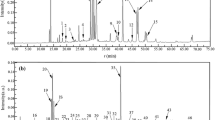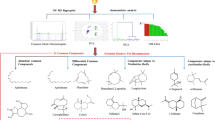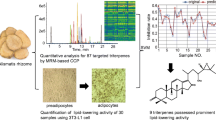Abstract
Quantitative composition-activity relationship (QCAR) study makes it possible to discover active components in traditional Chinese medicine (TCM) and to predict the integral bioactivity by its chemical composition. In the study, 28 samples of Radix Tinosporae were quantitatively analyzed by high performance liquid chromatography, and their analgesic activities were investigated via abdominal writhing tests on mice. Three genetic algorithms (GA) based approaches including partial least square regression, radial basis function neural network, and support vector regression (SVR) were established to construct QCAR models of R. Tinosporae. The result shows that GA-SVR has the best model performance in the bioactivity prediction of R. Tinosporae; seven major components thereof were discovered to have analgesic activities, and the analgesic activities of these components were partly confirmed by subsequent abdominal writhing test. The proposed approach allows discovering active components in TCM and predicting bioactivity by its chemical composition, and is expected to be utilized as a supplementary tool for the quality control and drug discovery of TCM.
Similar content being viewed by others
References
Cheng, Y.Y., Wang, Y., Wang, X.W. 2006. A causal relationship discovery-based approach to identifying active components of herbal medicine. Comput Biol Chem 30, 148–154.
Daren, Z. 2001. QSPR studies of PCBs by the combination of genetic algorithms and PLS analysis. Comput Chem 25, 197–204.
Faber, K., Kowalski, B.R. 1996. Comment on a recent sensitivity analysis of radial base function and multilayer feed-forward neural network models. Chemom Intell Lab Syst 34, 293–297.
Fan, X.F., Cheng, Y.Y., Ye, Z.L., Lin, R.C., Qian, Z.Z. 2006. Multiple chromatographic fingerprinting and its application to the quality control of herbal medicines. Anal Chim Acta 555, 217–224.
Harvey, A. 2000. Strategies for discovering drugs from previously unexplored natural products. Drug Discov Today 5, 294–300.
Harvey, A.L. 2008. Natural products in drug discovery. Drug Discov Today 13, 894–901.
Helland, I.S. 2001. Some theoretical aspects of partial least squares regression. Chemom Intell Lab Syst 58, 97–107.
Kong, W.J., Zhao, Y.L., Shan, L.M., Xiao, X.H., Guo, W.Y. 2008. Investigation on the spectrum-effect relationships of EtOAc extract from RadixIsatidis based on HPLC fingerprints and microcalorimetry. J Chromatog B 871, 109–114.
Kong, W.J., Zhao, Y.L., Xiao, X.H., Wang, J.B., Li, H.B., Li, Z.L., Jin, C., Liu, Y. 2009. Spectrum-effect relationships between ultra performance liquid chromatography fingerprints and anti-bacterial activities of Rhizoma coptidis. Anal Chim Acta 634, 279–285.
Leardi, R. 2001. Genetic algorithms in chemometrics and chemistry: A review. J Chemom 15, 559–569.
Leardi, R. 2005. Application of genetic algorithms to feature selection under full validation conditions and to outlier detection. J Chemom 8, 65–79.
Li, L., Jiang, W., Li, X., Moser, K.L., Guo, Z., Du, L., Wang, Q., Topol, E.J., Wang, Q., Rao, S. 2005. A robust hybrid between genetic algorithm and support vector machine for extracting an optimal feature gene subset. Genomics 85, 16–23.
Li, R.W., Leach, D.N., Myers, S.P., Leach, G.J., Lin, G.D., Brushett, D.J., Waterman, P.G. 2004. Antiinflammatory activity, cytotoxicity and active compounds of Tinospora smilacina Benth. Phytother Res 18, 78–83.
Li, R.W., Myers, S.P., Leach, D.N., Lin, G.D., Leach, G. 2003. A cross-cultural study: Anti-inflammatory activity of Australian and Chinese plants. J Ethnopharmacol 85, 25–32.
Liu, H.X., Zhang, R.S., Yao, X.J., Liu, M.C., Hu, Z.D., Fan, B.T. 2004. Prediction of the isoelectric point of an amino acid based on GA-PLS and SVMs. J Chem Inf Comput Sci 44, 161–167.
Liu, X., Lu, W., Jin, S., Li, Y., Chen, N. 2006. Support vector regression applied to materials optimization of sialon ceramics. Chemom Intell Lab Syst 82, 8–14.
Ma, S.C., Du, J., Bu, P.P., Deng X.L., Zhang, Y.W., Xu, H.X., Lee, S.H., Lee, S.F. 2002. Antiviral Chinese medicinal herbs against respiratory syncytial virus. J Ethnopharmacol 79, 205–211.
Normile, D. 2003. The new face of traditional Chinese medicine. Science 299, 188.
Rachel, W.G., David, L., Stephen, P.M., David, N.L. 2003. Anti-inflammatory activity of Chinese medicinal vine plants. J Ethnopharmacol 85, 61–67.
Sardari, S., Shokrgozar, M.A., Ghavami, G. 2009. Cheminformatics based selection and cytotoxic effects of herbal extracts. Toxicology in Vitro 23, 1412–1421.
Shi, Q., Yan, S., Liang, M., Yang, Y., Wang, Y., Zhang, W. 2007. Simultaneous determination of eight components in Radix Tinosporae by high-performance liquid chromatography coupled with diode array detector and electrospray tandem mass spectrometry. J Pharm Biomed Anal 43, 994–999.
Sieg, S., Stutz, B., Schmidt, T., Hamprecht, T., Maier, W.F. 2006. QCAR-approach to materials modeling. J Mol Model 12, 611–619.
Souza, B.F., Carvalho, A.P. 2005. Gene selection based on multi-class support vector machines and genetic algorithms. Genet Mol Res 4, 599–607.
Wang, X.W., Wang, Y., Cheng, Y.Y. 2005. Empirical study on modeling quantitative composition-activity relationships in Chinese herbal medicine. Conf Proc IEEE Eng Med Biol Soc Shanghai, China, 7722–7725.
Wang, Y., Wang, X.W., Cheng, Y.Y. 2007. A computational approach to botanical drug design by modeling quantitative composition-activity relationship. Chem Biol Drug Des 68, 166–172.
Yu, K., Gong, Y., Lin, Z., Cheng, Y., 2007. Quantitative analysis and chromatographic fingerprinting for the quality evaluation of Scutellaria baicalensis Georgi using capillary electrophoresis. J Pharm Biomed Anal 43, 540–548.
Zhang, G.Z., Huang, D.S. 2004. Inter-residue spatial distance prediction by using integrating GA with RBFNN. Protein Pept Lett 11, 571–576.
Zhang, Y., Shi, Q., Shi, P., Zhang, W., Cheng, Y. 2006. Characterization of isoquinoline alkaloids, diterpenoids and steroids in the Chinese herb. Rapid Commun Mass Spectrom 20, 2328–2342.
Zhao, X.M., Huang, D.S., Cheung, Y.M. 2005. A novel hybrid GA/RBFNN technique for protein classification. Protein Pept Lett 12, 383–386.
Author information
Authors and Affiliations
Corresponding author
Rights and permissions
About this article
Cite this article
Yan, SK., Lin, ZY., Dai, WX. et al. Chemometrics-based approach to modeling quantitative composition-activity relationships for Radix Tinosporae . Interdiscip Sci Comput Life Sci 2, 221–227 (2010). https://doi.org/10.1007/s12539-010-0026-9
Received:
Revised:
Accepted:
Published:
Issue Date:
DOI: https://doi.org/10.1007/s12539-010-0026-9




